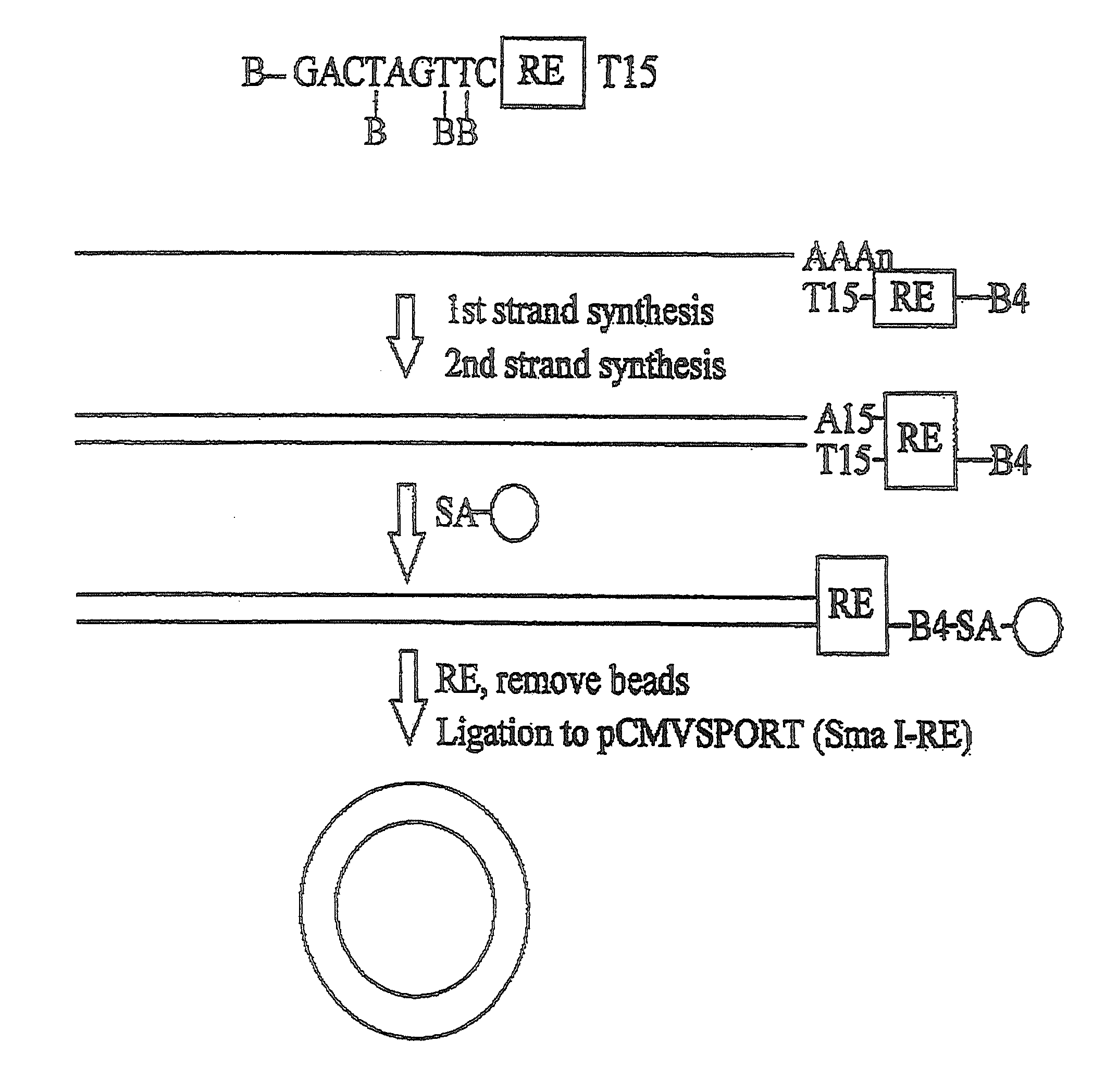Methods for production and purification of nucleic acid molecules
a nucleic acid and purification technology, applied in the field of molecular and cellular biology, can solve the problems of biased cdna libraries, loss of products and limitations in cdna yield, and methods still have several important limitations, so as to facilitate the selection of such sequences, facilitate the isolation of molecules, and reduce background contamination
- Summary
- Abstract
- Description
- Claims
- Application Information
AI Technical Summary
Benefits of technology
Problems solved by technology
Method used
Image
Examples
example 1
Production and Isolation of cDNA Molecules
[0083]First and second strand cDNA synthesis reactions were conducted as described in the instruction manual for the SUPERSCRIPT Plasmid System (Life Technologies, Inc., Rockville, Md.), except that 50-5000 ng of mRNA was used as starting material to produce a library of >106 clones. The primer-adapter used in cDNA synthesis contained four biotin (B) residues:
(SEQ ID NO: 1)B-GACT(-B)AGT(-B)T(-B)CTAGATCGCGAGCGGCCGCCC(T15).
[0084]Briefly, 1 μg of the biotinylated primer-adapter was used to prime first strand synthesis for 60 minutes, in a solution containing 50 mM TRIS-HCl (pH 8.3), 75 mM KCl, 3 mM MgCl2, 10 mM DTT, 500 μM each of dATP, dCTP, dGTP and dTTP, 50 μM / ml Bio-p-A and 10,000 to 50,000 units / ml SuperScript II reverse transcriptase (Life Technologies, Inc.). Second strand synthesis was performed for two hours at 16° C. using methods described previously (Okayama, H., and Berg, P., Mol. Cell. Biol. 2:161 (1982); Gubler, U., and Hoffman,...
example 2
Vector Ligation of cDNA and Introduction into Host Cells
[0088]From 10 to 50 ng of the cDNA was ligated into a vector (e.g., pCMVSPORT) and this ligation introduced into E. coli by transformation as described in the SUPERSCRIPT Plasmid System manual (Life Technologies, Inc.), except the cloning vector was pre-digested with NotI and SmaI. In one such ligation, 50 ng of vector was ligated to the cDNA in a 1.5 ml microcentrifuge tube with 4 μl of 5×T4 DNA ligase buffer (250 mM TRIS-HCl (pH 7.6), 50 mM MgCl2, 5 mM ATP, 5 mM DTT, 25% (w / v) PEG-8000) and 1 μl of T4 ligase (1 unit) at 4° C. for 16 hours.
example 3
cDNA Yield Comparisons
[0089]To examine the efficiency and yield of cDNA synthesis by the methods of the invention, cDNA was produced as described above and the amounts produced were compared to those obtained using an alternative commercially available system (SUPERSCRIPT Plasmid System; Life Technologies, Inc., Rockville, Md.). Briefly, after introducing the pCMV•SPORT-cDNA ligations into MAX EFFICIENCY DH5α™ and ELECTROMAX® DH10B cells, the cells were plated onto ampicillin-containing plates to determine transformation efficiencies. The cDNA inserts were sized by using the SP6 and T7 promoter primers and 40 cycles of PCR on 48 randomly chosen colonies for each experiment.
[0090]Table 1 shows a comparison of the cDNA yields obtained by the methods of the present invention to those obtained using the SuperScript Plasmid System.
TABLE 1Comparison of the Invention to the SUPERSCRIPT Plasmid System.Transformantsper ligationInput mRNA Yield of (MAXSystemper reactioncDNAEFFICIENCYAvg. Inse...
PUM
| Property | Measurement | Unit |
|---|---|---|
| pH | aaaaa | aaaaa |
| pH | aaaaa | aaaaa |
| pH | aaaaa | aaaaa |
Abstract
Description
Claims
Application Information
 Login to View More
Login to View More - R&D
- Intellectual Property
- Life Sciences
- Materials
- Tech Scout
- Unparalleled Data Quality
- Higher Quality Content
- 60% Fewer Hallucinations
Browse by: Latest US Patents, China's latest patents, Technical Efficacy Thesaurus, Application Domain, Technology Topic, Popular Technical Reports.
© 2025 PatSnap. All rights reserved.Legal|Privacy policy|Modern Slavery Act Transparency Statement|Sitemap|About US| Contact US: help@patsnap.com


